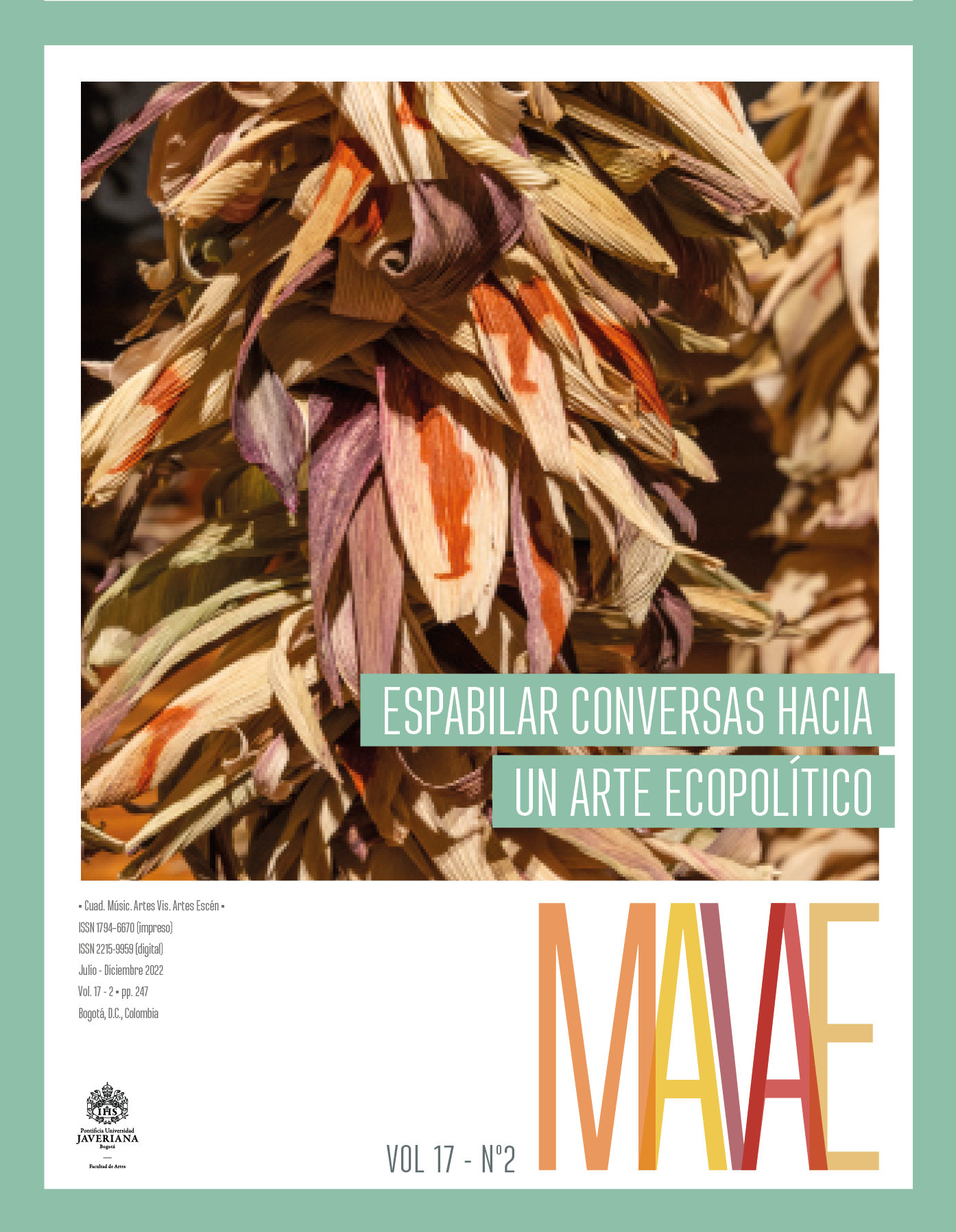Non-Anthropic Approaches: Counter-Narratives, Disobedience, and Other Visualities [
##plugins.themes.bootstrap3.article.details##
In this paper, we reflect on what we know as “non-anthropic approaches,” a category we propose to characterize the initiatives that do not follow the exceptional nature of the human. We suggest that this civilizing and anthropocentric construction that subjugates all beings to the domain and power of human nature must be continuously reviewed and transformed. The itinerary that we propose goes through different moments. First, we will describe what we understand by non-anthropic approaches, which will allow us to analyze and understand, based on two examples: the myths of origin and the interventions linked to bioart, the way in which stories and images are transformed, reconfigured and migrated. Then, through a hermeneutical-visual analysis of the bio-installation titled Deforestation: Unearthing signs at the Museum of Contemporary Art of Lima (MAC Lima), we will trace a path from the elements that make up the installation where oyster mushrooms appear as subjects of minuscule action that can confront the enormous devastation caused by the hegemonic model of the economies of the Western world. Finally, in our closing notes, we will reflect on the possibilities that these non-anthropic approaches have as a way of evidencing the positioning of artists and groups (in space) that mediate for a call to consciousness through artistic practice crossed by an ecopolitical position to resist overexploitation, transgression and usurpation of the land, nature, and the environment.
non-anthropic approaches, bioart, myths, bio-installationaproximaciones des-antrópicas, bioarte, mitos, bioinstalaciónabordagens desantrópicas, bioarte, mitos, bioinstalação
Arteinformado. 2015. “El papagayo de Humboldt”. hhttps://www.arteinformado.com/agenda/f/el-papagayo-de-humboldt-130207
Ascott, Roy. 2002. “Cuando el jaguar se tumba junto a la oveja: Especulaciones sobre la cultura posbiológica”. Artnodes: Revista de Arte, Ciencia y Tecnología 1. http://dx.doi.org/10.7238/issn.1695-5951.
Benítez Valero, Laura. 2013. “Bioarte: Una estética de la desorganización”.Tesis de doctorado, Universidad Autónoma de Barcelona. https://ddd.
uab.cat/record/118627
Blackmore, Lisa. 2017. “Ruinas modernas y arte contemporáneo: el caso del helicoide de la Roca Tarpeya”. Cuadernos de Literatura 21, n.º 42: 255-277. https://doi.org/10.11144/Javeriana.cl21-42.rmac
Bolognini, Mauricio. 2004. “Bioestética, arte transgenica e il coniglio verde: Conversazione con Eduardo Kac”. http://www.ekac.org/lux.flux.html.
Davis, Heather y Etienne Turpin. 2015. Art in the Anthropocene: Encounters among Aesthetics, Politics, Environments and Epistemologies. Londres: Open Humanities Press. https://library.oapen.org/handle/20.500.12657/33191
De Sousa Santos, Boaventura. 2010. Para descolonizar Occidente: Más allá del pensamiento abismal. Buenos Aires: Consejo Latinoamericano de Ciencias Sociales.
Deleuze, Giles y Felix Guattari. 2002. Mil mesetas: Capitalismo y esquizofrenia. Valencia: Pre-textos. http://kaleidoscopio.com. ar/fs_files/user_img/textos_estetica%20rececpcion/Deleuze_Guattari_Mil%20mesetas.pdf
Escobar, Arturo. 2010. Una minga para el posdesarrollo: Lugar, medioambiente y movimientos sociales en las transformaciones globales.
Lima: Universidad Nacional Mayor de San Marcos.Fibra Colectivo. 2020. “Desbosque: Desenterrando señales”. Cubo Abierto,n.º 3 https://maclima.pe/2020/12/11/cubo-abierto-3/.
Girard, René. 1995. La violencia y lo sagrado. Barcelona: Anagrama.
Heather, Davis y Etienne Turpin. 2015. Art in the Anthropocene. Encounteurs Among Aesthetics, Politics, Environments and Epistemologies.
Londres: Open Humanities Press.
Lévi-Strauss, Claude. 1955. Tristes trópicos. Madrid: Paidós.
Lévi-Strauss, Claude. 1974. Estructuralismo y ecología. Madrid: Paidós.
Lévi-Strauss, Claude. 1987. Mito y significado. Madrid: Alianza.
López del Rincón, Daniel. 2011. “Bioarte y entorno: De la artificialización de la naturaleza al artivismo biotecnológico”. Conferencia pronunciada en la Universidad Politécnica de Valencia, 16-18 noviembre.
Lozano, Ana María. 2017. “Los derechos de los vivientes”. Errata 18: 26-52.
MAC Lima (Museo de Arte Contemporáneo de Lima). 2021. “Desbosque: Desenterrando señales”. https://maclima.pe/project/desbosquedesenterrando-senales/.
Mauss, Marcel. 1971. Ensayo sobre los dones: Motivos y formas de intercambio en las sociedades primitivas. Madrid: Tecnos.
Mitchell, W. J. T. 1996. “What Do Pictures ‘Really’ Want?”. October 77:71-82. https://doi.org/10.2307/778960.
Sperber, Dan. 2005. Explicar la cultura: Un enfoque naturalista. Madrid:Morata.
Welsch, Wolfgang. 2004. “Epistemischer Anthropozentrismus”.Conferencia pronunciada en el Círculo de Bellas Artes de Madrid, noviembre.
Welsch, Wolfgang. 2014. Hombre y mundo: Filosofía en perspectiva evolucionista. Valencia: Pre-Textos.

This work is licensed under a Creative Commons Attribution 4.0 International License.


